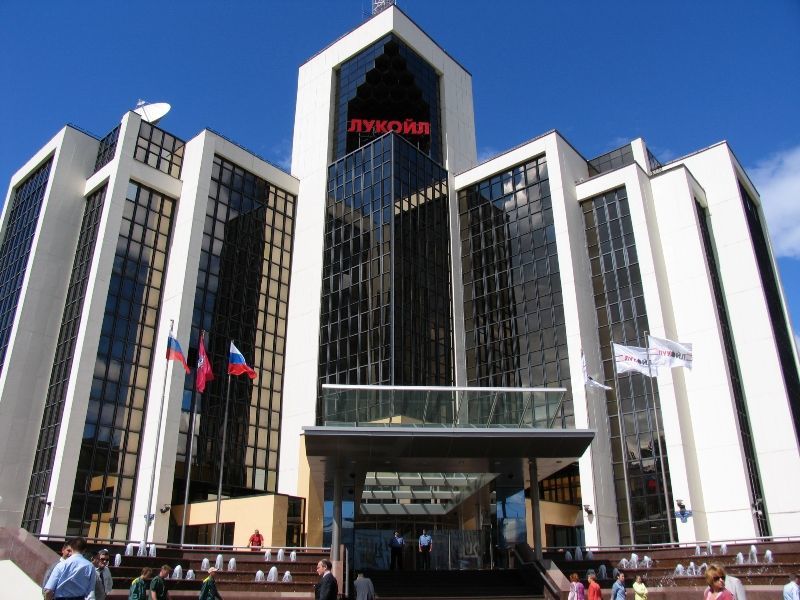
Investing in Russian oil has become a choice between cash or glory, and Lukoil PSJC looks like the richer side of the bet.
Russia’s second-largest oil producer has watched as state-run rival Rosneft PJSC came to command the nation’s industry — first by winning control of Yukos’s best assets a decade ago, then the $54 billion acquisition of TNK-BP in 2013, and finally last year’s purchase of Bashneft PJSC.
Despite its odd-one-out status, the smaller company looks like a better choice for cash-conscious investors. While Rosneft Chief Executive Officer Igor Sechin appears set on building an overseas empire to complement his dominance at home, Lukoil’s steady investment in new fields is expected to feed through into rising cash flow and dividends.
“Lukoil’s yield is an anchor for the stock,” said Ildar Davletshin, an oil and gas analyst at Renaissance Capital. “The market wants dividends.”
At current share prices, Lukoil investors can look forward to a return of 6 or 7 percent this year, potentially reaching 9 percent by 2020, according to analysts including Goldman Sachs Group Inc. In contrast, the yield for Rosneft from 2016 earnings is set to be below 2 percent, according to calculations based on the company’s earnings. It also plans a second interim dividend this year from 2017 profits.
Rosneft’s Appetite
The divergence between Russia’s biggest producers looks set to continue.
While Rosneft has pledged to pay out 35 percent of its net profit to shareholders, it will continue to gobble up assets. The company has set aside $9.2 billion for closing acquisitions of an Indian refinery, an Egyptian gas field and shares tendered by the remaining minority investors in Bashneft, according to a presentation of fourth-quarter results.
Rosneft’s growing influence comes at a cost. The company’s total debt rose to about $59 billion last year — the largest for any Russian company. International sanctions imposed after President Vladimir Putin annexed Crimea and supported a separatist insurgency in Ukraine mean Rosneft is cut off from European Union and U.S. lenders, reducing its financial flexibility.
Rosneft is paying out the highest proportion of its net income to shareholders among Russian oil producers and state-led companies, its press service said by email. Dividends have grown faster than the majority of its competitors over the past five years, it said.
New Fields
After years of heavy investment to maintain its production, Lukoil is now completing projects, the largest of which is the Filanovsky field in the Caspian Sea. That means spending could be 10 percent lower this year than in 2014, potentially boosting cash flow, Bank of America Merrill Lynch said in a March 6 research note.
Both companies will benefit by pumping more from new tax-exempt deposits — including Filanovsky — which allow them to capture a greater share of the gains from higher oil prices. Lukoil’s tax-exempt output will more than double to 10.2 million tons this year, while Rosneft’s will more than triple 10.6 million tons, according to the Bank of America note.
Meanwhile, Lukoil has responded to Russia’s December production-cuts agreement with the Organization of Petroleum Exporting Countries, which initially raised international prices by about 20 percent, by reducing output at its least-profitable and highest-taxed fields.
Lukoil’s press service declined to comment.
More Cash
Shirking acquisitions, selling assets and focusing on production mean Lukoil can now expect higher dividends and free cash flow, and lower capital expenditure, Goldman Sachs analysts Geydar Mamedov, Elena Malareva and Georgii Gorbatov wrote in a Feb. 22 research note.
European peers may offer similar cash-flow yields, but they come at the expense of big cuts in investment for the future, which isn’t the case for the Russian companies, Bank of America said.
Lukoil and Rosneft have dropped this year, along with other Russian equities, as the possibility that U.S. President Donald Trump’s administration would remove sanctions became more remote. The state-run oil giant has fallen faster, losing 20 percent compared with a 14 percent decline for its its smaller rival.
The share slide offers “a particularly good opportunity to buy,” said Bank of America analysts Karen Kostanian and Anton Fedotov. The yield on Lukoil’s payout right now looks to be one of the most attractive in Russian oil and gas, said Alexander Kornilov, an analyst at Aton LLC.
“If you are a dividend seeker, Rosneft isn’t for you,” he said.